The loop that I like to run around Umbagong Park is still closed. Apparently bridges need to be repaired. I understand that, but they have been closed for about eighteen months now and no discernible work has been done on any of them. I wrote to the council about it this time last year and received no reply. I have written again. Clearly people have taken matters into their own hands and just cut through the gates.
This little fellow looks untroubled, however.
On a stinking hot day (30 degrees), I decided to bag another trig point (see previous post) in my lunch break. Mt Waniassa is a good walk with a pleasant track to the summit. On the way round I listened to the Joe Wicks Podcast - Mark Cavendish: There Is Always a Finish Line (very inspirational).
 |
| Trig in the distance |
 |
| Nearly there |
 |
| The view from Mt Waniassa |
 |
| Relief to reach the top |
 |
| Coming down |
We went to Sydney for the weekend, mainly to see Amadeus at the Opera House, but obviously we did other things too. Coming into Circular Quay by train is always really impressive - I mean that view has got to be one of the best from a train station ever.
 |
| Still terrible at selfies, though |
Interesting décor in Wolfie's Bar and a spectacular view at half time.
After the show we sat by the water at the Opera Bar and enjoyed the warm (storm-filled) evening.
The next day we walked to breakfast at Blacksmith - a café in Surry Hills with a quirky rustic vibe, excellent service and fantastic food. We arrived just before it started pouring rain and stayed until it had passed, discussing the play we had seen last night.
 |
| The Artisan Benny - poached eggs, smoked salmon, kimchi potato rosti, smashed edamame, chia seeds, snow pea tendrils and hollandaise |
We walked around Barangaroo Reserve and came across this artwork by Brenda L Croft: Naabami (thou shall/ will see): Barangaroo (army of me). The artwork honours Barangaroo, renowned for her fisherwoman skills and her standpoint as a steadfast First Nations woman who, during a time of immense upheaval and overwhelming change, determined how she would live and die on First Nations traditional lands.
"Large-scale photomedia portraits of contemporary First Nations women and girls reflect diverse representation of Barangaroo's ongoing inspiration, cultural continuity and connection to spirit and place.
Cammeraygal woman Barangaroo is the constant Ancestral guide for this artwork, which responds to her namesake site - reclaimed and reconstructed land on Warrane (Sydney Harbour) - situated opposite the island homeland of her husband Bennelong, Me-mel (Goat Island).
First Nations names, clans, nations and language-words are used as place-names throughout Australia, often with minimal reference to the source. The act of naming this newest part of Sydney's CBD as Baranagaroo, inspired by her acknowledges the Cammeraygal woman. No matter the new buildings and geographical reclamation, re-landscaping or layering that occurs, the spirit of Barangaroo is omnipresent, embedded into the cultural DNA of this area, irrespective of the un-naming, naming and re-naming of contested sites."
"The portraits involve 19th century wet plate collodion and digital processes, ancient cosmologies, old technologies - to reinvigorate and reimagine. Stripped back, raw, strong in stance and knowledge, the portraits are revelatory - 21st century First Nations women and girls, standing not only as avatar-sentinels of a staunch 18th century Cammeraygal woman, but as contemporary sovereign warriors.
Barangaroo's role as cultural negotiator, at the time of first colonial contact, makes her as relevant today as in the late 18th century, more than 230 years after her death."
The Sydney Festival is currently on leading to burst of colour and performance at every turn. In the Cutaway there is a Fridha Kahlo immersive exhibition where one can be surrounded by images from her art (although none of her actual art is on display), make flower crowns, listen to music and sip cocktails in an suitable ambient atmosphere. These immersive exhibition are all the rage and, while I's sure the digital expertise is amazing, I would rather see the original artwork and interact with it in my own mind.
As we continued our walk around the peninsula, we came across multiple steps. There are a lot of steps in Sydney and one could have a very good step/hill work-out by linking them all together. It's a lot like Edinburgh in that respect (apart from the weather, of course).
We wandered through the Rocks market, which was pretty busy, and I particularly like the colourful food and beverage stalls. We fortified ourselves with a hearty and healthy fresh juice.
As we continued our walk, we encountered another cruise liner in the harbour - it seems people are over their COVID fears and back into the swing of things. The ropes which tether these huge boats to the moorings are fascinating pieces of engineering as they are put under a lot of slack and strain.
We caught the Manly ferry (a much smaller boat) out to the Northern Beaches. This is one of my favourite ways to view the harbour as we pass the famous landmarks.
Over in the Northern Beaches, we met up with an ex-colleague of Him Outdoors who was keen to take us for a bit of a brewery tour. Obviously we liked the sound of this one - starting out with Bucketty's Brewing Co. The Sunday Bitter (even though we drank it on a Saturday) on handpump was good and nutty with a good level of English hops. There were three different IPAs: standard; West Coast (Made with Citrus, Rock Melon, Stone Fruit, medium body, amarillo, Citra, Simco, Strata, Mosaic hops) and Cold IPA - despite the first one being very pale in appearance, they were all were good examples and distinctive.
Next stop was Dad and Dave's, which was literally around the corner. I had a Citrus and Mosaic IPA (which had a touch of berry flavours), a Belgian IPA which is a strange but pleasant balance of yeast and bitterness, and a Cold IPA which uses Nelson Sauvin hops for a crisp and deceptively refreshing (6.8%) brew.
Freshwater Brewing is around the next corner (literally - this is a brewery block) but was closed for a private function so we went over the road to 7th Day instead. Their IPA was much darker - almost red - with tropical flavours and a touch of blueberry. Other beverages were available.
From here we caught a bus back to central Sydney, which took us over the harbour bridge - another new perspective - and we walked back to our hotel via a couple of quiets in The Royal Albert, a favourite watering hole.
Sunday morning and time to walk to another café for breakfast. This time we chose to walk to Pyrmont and went to the Quick Brown Fox Eatery. Once again the service was good (although the Sunday surcharge was a bit steep) and the food was tasty and well-presented. It's another characterful café (Sydney is full of them) with tables in odd-shaped rooms and on the pavement under the trees. Him Outdoors had the Waffle Benedict (potato waffle, spinach, ham off the bone, poached eggs and hollandaise) and I had the chef's favourite, XO Congee, described as 'housemade XO, 63 degree egg, glazed speck and shallot'.
 |
| Waffle Benedict |
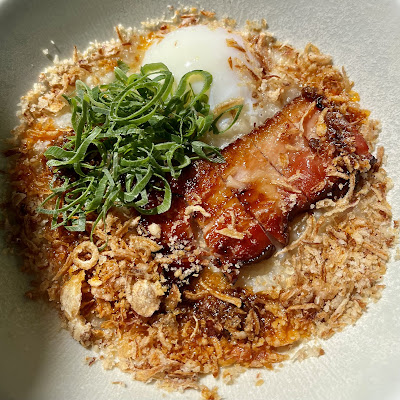 |
| XO Congee |
We continued our walk up and down hills and into little back-streets and courtyards, including this little enclave.
Apparently most of the buildings on the block surrounding the park were built in the 1870s as the Colonial Sugar Refining Company (CSR) moved into Pyrmont. They included sandstone, rick and weatherboard cottages, terraces and shops for the growing industrial workforce. The former Pyrmont Arms hotel, next to the park, was built in 1879. In the mid 1870s, nearby residents included engineers, an iron roller, shipwright, master mariner, carpenter, blacksmith, tobacco twister, and grocer.
Sydney City Council bought the block in 1951 to make the park, They repaired some houses, which were in very poor condition, to make them habitable. Some had no bathrooms and water leaked into electrical wiring. three stone cottages stood where the park is now.
The remaining buildings have survived several attempts to demolish them for large public housing projects. From 1979-94 squatters occupied them. The squatters, local activists and heritage bodies have ensured that the block remains as a rare surviving pocket of late 19th century workers' housing in Pyrmont.
We then walked around Pirrama Park with glorious views across the harbour, children's playgrounds, fishing vantage points (although it is not recommended you eat anything you catch and you are encouraged to release it all back), a grassy picnic area, and some interesting public art. It is also a designated family-friendly secure site from which to watch the New Year's Eve fireworks from the western side of the Harbour Bridge.
This is a kinetic sculpture that translates the eternal return of the tides as well as the more unpredictable wave wash and wind chop of Sydney Harbour into movement. Red ladders respond to the wind, and counter-balanced hardwood beams are connected to a float that transmits the water's movements along their length. The tides lower and raise the beams, hovering close and almost parallel to the water's surface at high tide and angling high above the receding watermark at low tide. I felt lulled watching the beams bob gently in the calm conditions, although when it is choppy, their action is designed to be more staccato.
 |
| Tied to Tide (1999) by Jennifer Turpin and Michaelie Crawford |
 |
| Life from a Suitcase (2009) by Terrance Plowright |
The life-sized bronze sculpture, created by Terrance Plowright, was gifted to Australia by the Signorelli family as a celebration of immigration. It sits on the site of the former Pyrmont Wharves 12 and 13, that until 1994 were Sydney's reserve passenger terminal. For large numbers of immigrants during the 1950s and 1960s, this is where they first stood on Australian soil.
The theme of Life from a Suitcase is a celebration of immigration into Australia. Many arrived with a single suitcase of belongings, planted their roots, raised families, and in some cases built vast enterprises. They have now contributed to the vibrant, yet peaceful, multi cultural society that Australia is today.
Most entering via Pyrmont Wharves 12 & 13 came from war-torn areas of southern Europe that were then steeped in poverty. Doltone House, a collection of event venues around Sydney, including one here in the redeveloped wharf building behind the sculpture.
 |
| Windjammer Sailors by Brett Garling |
By the Maritime Museum, a collection of poles displays some intriguing photographic artworks explained as Ocean Wonders: 'The waters surrounding Australia plunge to 7,000 metres deep - almost impossible for humans to reach. It takes an intrepid team of scientists, a great big research ship and high-powered cameras on a deep-diving robot to find out what's down there.
While most of us were locked down at home over 2021 Schmidt Ocean Institute made a series of voyages on their Research Vessel (RV) Falkor. Hundreds of dives explored the depths of the Indian and Pacific oceans and Arafura and Coral seas. Scientists jumped on board, or tuned in remotely, to record, collect and classify the wonders they discovered.'
'Most of the images in this exhibition are from within marine reserves where underwater life can flourish. However, it can be a different story in unprotected waters. Scientists worldwide are now in a race to locate and catalogue these wondrous species - and to map underwater features before it's too late.'
 |
| Short-nosed or Shaul reef sea snake (Aipysurus apraefrontalis) |
'It's wonderful when scientists find a creature they thought was extinct or on the verge of vanishing. The team aboard RV Falkor was excited to find this species of sea snake down at 67 metres, as it is considered functionally extinct in the reef's shallower waters.
Functionally extinct means that, although a few individual animals may live in an area, there aren't enough of them to continue the population. Finding this critically endangered snake suggests that, while they are disappearing in shallow waters, some healthy breeding populations may survive in deeper areas.'
 |
| Deep-sea squid (Chiroteuthidae) |
'This deep-sea squid is hard to spot and even harder to catch. Its gelatinous body is too soft for many traditional collection methods, because it literally slips through the net. This is why recording with high-powered cameras is vital to understanding its behaviour.
These animals have long necks, slender bodies and thin tentacles, so are sometimes called whip-lash squid.
When they are young, they live in the upper water column. They are long for their size (about 78 centimetres) and eat zooplankton (tiny animals). When they grow up, they lose their tails.'
 |
| Glass octopus (Vitreledonella richardi) |
'As their name suggests, glass octopuses are really hard to see, because they're almost transparent. ROV SuBastian's lights illuminate this specimen, but usually only their optic nerves, eyeballs and digestive tracts are visible. It's a great way to hide from predators and prey - and from researchers.
So RV Falkor's svientists were thrilled to spot not one, but two of these see-through cephalopods on the recent exhibition. Cephalopod means 'head-foot' - creatures like octopuses and squids whose tentacles emerge directly from their heads.'
 |
| Dana (or Tåning) octopus squid (Taningia danae) |
'This 1.5 metre-long octopus squid flashed a warning when startled by ROV SuBastian, It has large light-producing organs called photophores on the tips of its top two arms, which create flashes of bioluminescent light.
How can it be both an octopus and a squid? It starts out with long octopus tentacles, but as it ages, its tentacles shrink, becoming more squid-like.
The octopus squid is named for biologist Age Vedel Tåning, who voyaged on the early 20th-century Danish oceanographic vessel Dana. Although the species had previously been seen in the Indian Ocean, this was the first time that it had been recorded in Western Australian waters.'
'Jellies are hard to study - they're delicate, gelatinous and many live in the less-researched midwater part of the ocean. But Dr Dhugal Lindsay, from the Japan Agency for Marine-Earth Science and Technology, is on the case. Also known as 'The Jellyman', Dr Lindsay used the ROV SuBastain to conduct a midwater jelly survey off K'gari (Fraser Island). He wanted to discover which species were there, how numerous they were, and at what depths they lived.'
Inside the museum we explored a couple of exhibitions, and generally enjoyed the surroundings - these sculptures of sharks are particularly fun.
Afterwards we walked back through Darling Harbour past this fun and colourful installation, Cupid's Koi by ENESS studio. The brightly-coloured inflatable fountains splash water, play hypnotic music and have motion-tracking LED 'eyes'. Bizarre but cute.
A final piece of public art on Dixon Street in Chinatown, before we boarded our bus to return to Canberra.














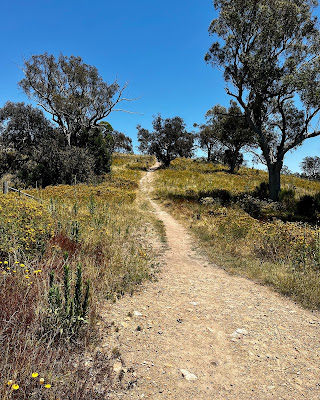

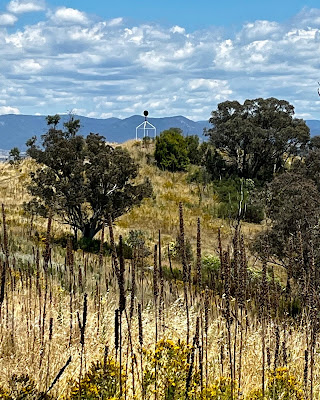
























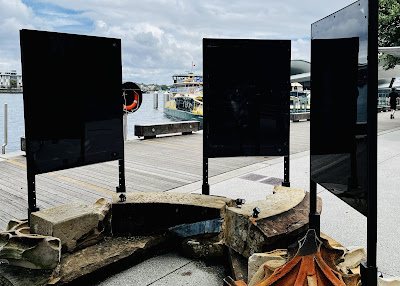






















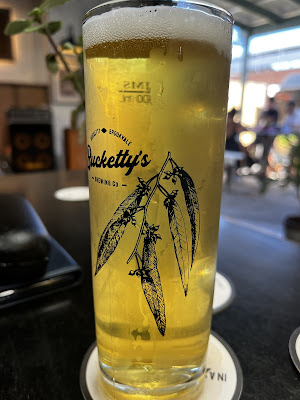








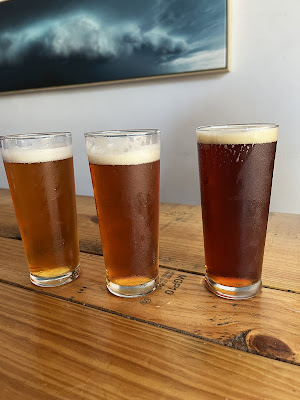




























No comments:
Post a Comment